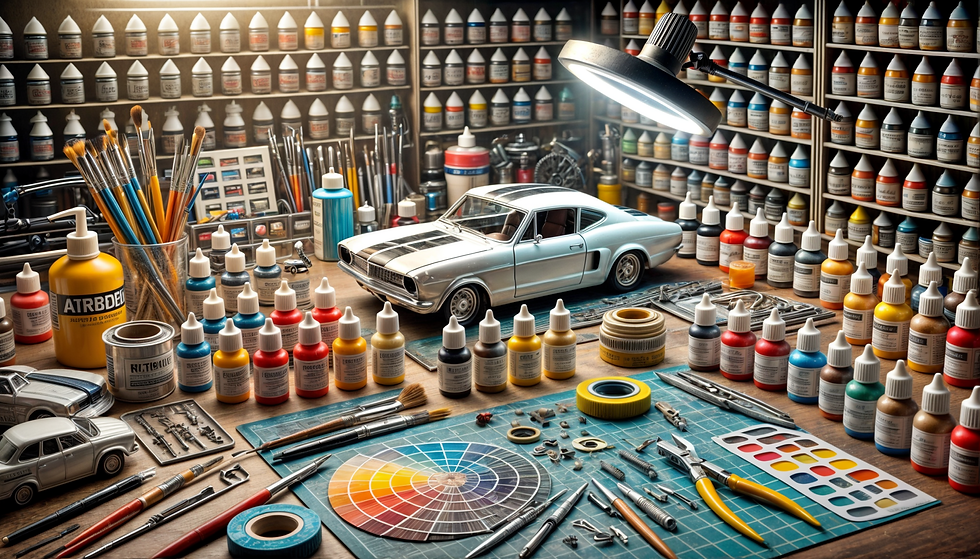How to Remove the Decals from Hot Wheels Diecast Cars
- Danny Abramovich
- Jan 2
- 8 min read
Updated: Jan 5
Removing decals from Hot Wheels diecast cars can be both an art and a science. Whether you’re a dedicated customizer or a hobbyist eager to make your collection look unique, getting rid of unwanted graphics or tampos (the brand’s specialized ink print) is a common task. However, not all decals come off easily. Each type of print, whether it’s an older style or a modern-day tampo, can have different levels of adhesion. If you rush the process or use the wrong technique, you risk damaging the paint or the delicate metal underneath. In this comprehensive guide, we’ll walk you through everything you need to know about how to safely and effectively remove decals from your Hot Wheels diecast cars. From preparing your workspace to choosing the right materials, as well as insider tips for preserving the car’s overall integrity, consider this your ultimate roadmap to customizing your favorite miniature vehicles.

Decal removal isn’t just a practical skill; it’s also the first step in many creative journeys. Some collectors love the challenge of transforming their Hot Wheels into original, one-of-a-kind displays or racing replicas. Others simply want to achieve a cleaner aesthetic, removing the sometimes-busy graphics that come from the factory. Whatever your goal, remember that practice makes perfect. The more cars you work on, the better you’ll become at choosing the right method and ensuring a smooth finish.
In the sections below, we’ll outline the tools you’ll need, the step-by-step process, key considerations to avoid damage, and helpful tips for ensuring your car looks pristine once you’re done. Keep in mind that every Hot Wheels model might behave a little differently—some paints or coatings react differently to certain chemicals—so always test your method on a less-valuable model or on a small hidden patch of the car if you’re uncertain. Let’s dive into the details and get those decals off.
1. Tools and Materials
To remove decals effectively, you’ll need the right combination of tools and materials. Below is a basic list of what you’ll want to gather before you start the process:
Cotton Swabs and Soft Cloths
Cotton swabs (Q-tips) are indispensable for applying solvents in precise areas. Soft, lint-free cloths or microfiber towels help you gently buff or wipe away any residue without scratching the surface of the car.
Solvents (e.g., Acetone, Rubbing Alcohol, or Nail Polish Remover)
Solvents are your best friends when it comes to loosening decal adhesives and tampo prints. Acetone and nail polish removers with acetone can be very effective, but they also carry a higher risk of damaging paint if not used carefully. Rubbing alcohol (isopropyl alcohol) is gentler, though it can be slower to work. If you’re new to decal removal, you might start with a lower-strength solvent and work your way up as needed.
Masking Tape or Painters Tape
Tape can serve multiple purposes. You can use it to protect areas of the car’s paint or to provide a little extra control over where the solvent goes. Some customizers also use tape to lift off loosened decals gently, rather than scrubbing or scraping the paint.
Toothpicks or Wooden Skewers
These are useful for delicately scraping away small areas of decal once the solvent has started to break down the adhesive. The key is to choose something that is softer than metal, reducing the chances of gouging the diecast surface.
Protective Gloves
Always protect your hands when working with chemicals like acetone or high-percentage isopropyl alcohol. Nitrile or latex gloves will help keep your skin safe and prevent any unwanted contact with potentially harsh solvents.
Protective Eyewear and Ventilation
Make sure you’re working in a well-ventilated area, especially if you’re using strong solvents. It’s always better to be safe and wear protective eyewear, too, in case of accidental splashes.
Water and Mild Soap
These come in handy for cleaning off any remaining residue and neutralizing the surface after you’ve applied solvents. A gentle wash can make a big difference in the final look.
Gather all these materials before you begin. It’ll make the process smoother, and you won’t have to scramble around mid-project.
2. Step-by-Step Instructions
Step 1: Prepare Your Workspace
Set yourself up in a well-lit and well-ventilated area. Lay out a protective covering on your work surface, such as old newspapers or a silicone mat, to avoid spilling solvents on your table or desk. Keep your tools within easy reach so that you can work efficiently.
Step 2: Clean the Car
Before you attempt to remove any decals, give the car a quick clean. Use mild soap and water to remove dust and any surface debris. Pat the car dry with a soft cloth and allow it to air-dry completely. A clean surface makes the decal removal process
more predictable.
Step 3: Mask Off Sensitive Areas
If your goal is to remove a specific graphic without damaging the surrounding paint or other decals, use masking or painters tape. Tape off any logos, edges, or detail areas you want to preserve. This extra step helps ensure that solvent doesn’t inadvertently bleed into areas you want to keep intact.
Step 4: Apply the Solvent
Using a cotton swab, carefully dab a small amount of solvent—acetone, nail polish remover, or rubbing alcohol—onto the decal you want to remove. Start gently, focusing on one section of the decal at a time. Let the solvent sit for a few seconds to loosen the adhesive and ink. This waiting period is crucial to avoid excessive scrubbing, which can damage the paint beneath.
Step 5: Loosen and Lift the Decal
After the solvent has had a moment to work, use a toothpick, wooden skewer, or even the tip of a cotton swab to begin gently scraping or rubbing the decal. If the decal doesn’t come off easily, apply a little more solvent and wait a bit longer. The key is to be patient: forcing the decal off can result in scratches or peeled paint.
Step 6: Wipe Away Residue
Once the decal starts to lift, gently wipe the loosened ink and adhesive residue away using a clean cotton swab or soft cloth. If the decal is coming off in small chunks, you might find it easier to wipe in between applications of solvent. Always check the surface to ensure you’re not removing any of the base paint.
Step 7: Rinse and Inspect
After the decal is mostly off, rinse the car under lukewarm water (or wipe it down with a slightly damp cloth) to remove any remaining solvent. Pat the car dry and inspect your work. If there are still traces of the decal, repeat the solvent application and gentle scraping steps.
Step 8: Final Cleaning
Once you’re happy with the result, wash the entire car lightly with mild soap and water to remove any chemical residue. Dry it thoroughly with a soft towel. At this point, you can decide if you want to polish or repaint the car to your liking.
Following these steps carefully should yield a clean surface free from most decals and tampos. Remember, patience and attention to detail are essential if you want to keep your Hot Wheels in pristine condition.
3. Common Pitfalls and How to Avoid Them
Using Too Much Solvent
It’s tempting to douse the car in acetone, thinking it will speed up the process. However, too much solvent can quickly eat through the paint underneath the decal, leaving you with splotches or bare metal. The better approach is to use small amounts repeatedly, gradually loosening the decal instead of overwhelming it.
Scraping Too Aggressively
Even if you’re using a wooden toothpick, gouging or scratching is still possible. If the decal isn’t budging, reapply solvent rather than applying brute force. Aggressive scraping is the number one way collectors accidentally ruin their diecast finish.
Ignoring Test Spots
Different Hot Wheels releases might have different kinds of paint or protective coatings. Always test your chosen solvent on a small, inconspicuous area—perhaps on the underside of the chassis or inside the wheel well—before you commit to removing a large decal. This quick check can save you from heartbreak if the paint starts to lift unexpectedly.
Forgetting to Mask Off Areas
If you only want to remove one decal but skip this crucial step, you risk the solvent spreading to other parts of the car. Masking tape or painters tape is a cheap and easy way to protect areas you don’t want to disturb.
Lack of Ventilation or Proper Safety Measures
Working with solvents can lead to fumes. If you’re not in a well-ventilated area, you risk inhaling chemical vapors. At a minimum, keep windows open and wear gloves and goggles to protect yourself. Safety should be paramount, so don’t skip these precautions.
4. Additional Tips and Tricks
Slow and Steady Wins the Race
If you’re not getting immediate results, don’t panic. Different decals may require different waiting times for the solvents to work effectively. Multiple short applications of solvent and gentle scraping will usually remove the decal more safely than one intense application.
Use Gentle Pressure
Whether wiping or scraping, gentle pressure is key. Think of this process like peeling off a sticker—you wouldn’t yank it off all at once if you want to avoid tearing or residue. Treat the decal similarly, giving it the time and gentle nudges needed to come off cleanly.
Consider Alternative Removal Methods
For particularly stubborn or old decals, some collectors experiment with specialized products like commercial decal removers designed for model kits. While acetone and alcohol are more common, a specialized formula might be safer for certain paint types or less likely to mar the base finish.
After-Removal Finishing
If you plan to customize or repaint the car, removing the decal is just step one. You may want to lightly sand the area or apply a primer if you’re aiming for a uniform new paint job. If you’re leaving it in the factory color, a bit of polish can help the paint retain its shine and hide any minor abrasions left by the decal removal process.
5. Conclusion
Removing decals from Hot Wheels diecast cars is a rewarding skill that opens up a world of customization possibilities. Whether you want a clean canvas for your own custom paint job or simply prefer a more minimalistic look, mastering the art of decal removal can elevate your collection to the next level. The key ingredients are patience, the right materials, and a steady hand. Always remember to test your method on a less-valuable model first and take the time to prepare your workspace properly. By masking off the areas you want to keep pristine and using controlled amounts of solvent, you can avoid the most common mistakes like paint damage and scratches.
Don’t forget that each car might behave differently based on its production year, paint type, and decal style. With experience, you’ll develop a sense for how much solvent to use, how long to let it sit, and how much pressure to apply when scraping. And, of course, never overlook safety measures—ventilation, gloves, and eye protection are essential when dealing with chemicals. Once you’ve successfully removed your decal, a mild cleaning and a quick polish will bring out the full potential of your diecast model.
Now that you know the basic steps and pitfalls, you’re ready to transform any Hot Wheels car into a one-of-a-kind masterpiece. Whether you’re going for a sleek, decal-free hot rod or prepping for a full-blown custom repaint, removing the factory tampo is often the first step in making your vision a reality. So roll up your sleeves, gather your tools, and get ready to breathe new life into your favorite miniature machines. With practice and care, you’ll be peeling away decals like a pro in no time—and you’ll have a collection that truly reflects your individual style.




Comments